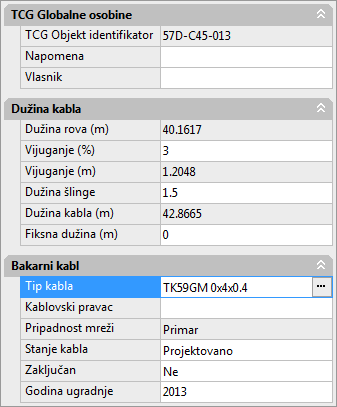Copper Cable (Designed)
| Command: | Copper Cable (Designed) |
| Menu path: | Copper > Copper Cable (Designed) |
| Icon: | 
 |
| Functional description: | Adds copper cable with the property - Designed. |
By using the Copper Cable (Designed) command
it is possible to lay three types of copper cables:
- Feeder and/or distribution cable
- Drop cable (underground)
- Drop cable (aerial)
Copper cable - Feeder/Distribution network
Laying the cables between the nodal elements of the feeder/distribution
network you’ll get the feeder/distribution network copper cable.
Feeder/Distribution network nodal elements are:
- Telephone Exchange
- Feeder Distribution Interface (FDI)
- Splices (distribution network)
- Distribution terminals (DT)
- PT (Public Telephone)
- Slack loops

An example of a cable laid in distribution network.
Copper cable - Underground drop plant
Drop plant underground cable is created by laying cable from the DTs
to the drop plant nodal elements elements,
if the DTs from which the cables are laid are of the following type:
- Pedestal DT

Also, drop plant underground cable is created by lying cables from the
splice point (drop plant)
to the drop plant elements, if the splice point is not
on the telephone pole (i.e. burried splice).
Copper cable - Aerial drop plant
Drop plant aerial cable is created by laying cable from the DT to the
drop plant elements,
if the DTs from which the cables are laid are of the following type:
- Aerial pole-mount DT

- Aerial roof-mount DT

Also, drop plant aerial cable is obtained by laying cables from the
splice point (drop plant)
to the drop plant elements, if the splice point is on
the pole.
Copper Cable (Designed) command enables
the laying of copper cable with predefined properties.
These properties can be changed through the Properties
window.
By laying in this way, you’ll get the cable with the following properties:
Properties
Cable laying procedure
Cable laying procedure is the same for all cables.
The only difference is in the properties assigned to the cable upon laying.
The procedure is described on Copper cable
laying page.
| Addition: |
If during the cable laying, you click on an element that
does not belong to the copper network (e.g. a manhole or ODF), |
